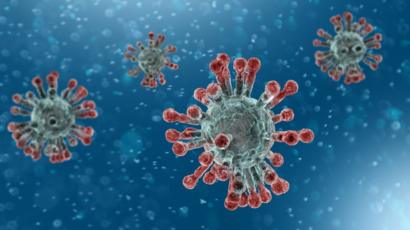As coronavirus continues to make the news, a host of untruths has surrounded the topic. In this Special Feature, we address some of these myths and conspiracy theories.
The novel coronavirus, now known as SARS-CoV-2, has spread from Wuhan, China, to every continent on Earth except Antarctica.
The World Health Organization (WHO) officially changed their classification of the situation from a public health emergency of international concern to a pandemic on March 11, 2020.
The virus has been responsible for millions of infections globally, causing hundreds of thousands of deaths. The United States is the most affected country.
As ever, when the word “pandemic” starts appearing in headlines, people become fearful — and with fear come misinformation and rumors.
Here, we will dissect some of the most common myths that are currently circulating on social media and beyond.
1. Spraying chlorine or alcohol on the skin kills viruses in the body
Applying alcohol or chlorine to the body can cause harm, especially if it enters the eyes or mouth. Although people can use these chemicals to disinfect surfaces, they should not use them on the skin.
These products cannot kill viruses within the body.
2. Only older adults and young people are at risk
SARS-CoV-2, like other coronaviruses, can infect people of any age. However, older adults and individuals with preexisting health conditions, such as diabetes or asthma, are more likely to become severely ill.
3. Children cannot get COVID-19
All age groups can contract SARS-CoV-2.
So far, most cases have been in adults, but children are not immune. In fact, preliminary evidence suggests that children are just as likely to contract it, but their symptoms tend to be less severe.
4. COVID-19 is just like the flu
SARS-CoV-2 causes an illness that does have flu-like symptoms, such as aches, a fever, and a cough. Similarly, both COVID-19 and the flu can be mild, severe, or, in rare cases, fatal. Both can also lead to pneumonia.
However, the overall profile of COVID-19 is more serious. Estimates vary, but its mortality rate seems to be between about 1% and 3%.
Although scientists are still working out the exact mortality rate, it is likely to be many times higher than that of seasonal flu.
5. Everyone with COVID-19 dies
This statement is untrue. As we mentioned above, COVID-19 is only fatal for a small percentage of people.
In a recent report, the Chinese Center for Disease Control and Prevention concluded that 80.9% of COVID-19 cases were mild.
The WHO also report that around 80% of people will experience a relatively mild form of the disease, which will not require specialist treatment in a hospital.
Mild symptoms may include a fever, a cough, a sore throat, tiredness, and shortness of breath.
6. Cats and dogs spread coronavirus
Currently, there is little evidence to suggest that SARS-CoV-2 can infect cats and dogs. However, in Hong Kong, a Pomeranian whose owner had COVID-19 also contracted the virus. The dog did not display any symptoms.
Scientists are debating the importance of this case to the outbreak. For instance, Prof. Jonathan Ball, a professor of molecular virology at the University of Nottingham in the United Kingdom, says:
“We have to differentiate between real infection and just detecting the presence of the virus. I still think it’s questionable how relevant it is to the human outbreak, as most of the global outbreak has been driven by human-to-human transmission.”
He continues: “We need to find out more, but we don’t need to panic — I doubt it could spread to another dog or a human because of the low levels of the virus. The real driver of the outbreak is humans.”
7. Face masks always protect against coronavirus
Healthcare workers use professional face masks, which fit tightly around the face, to protect themselves from infection.
Disposable masks are unlikely to provide such protection, and they will not block tiny viral particles. However, a cloth mask can help prevent the spread of droplets.
The Centers for Disease Control and Prevention (CDC) recommend that all people wear cloth face masks in public places where it is difficult to maintain a 6-foot (2-meter) distance from others. This will help slow the spread of the virus from asymptomatic people and those who do not know that they have contracted it.
When wearing a mask, it is essential to continue with other precautions, such as not touching the face and practicing physical distancing.
Instructions for making masks at home are available here.
Surgical masks and N95 respirators provide greater protection, but these are reserved for healthcare workers only.
8. Hand dryers kill coronavirus
Hand dryers do not kill coronavirus. The best way to protect oneself and others from the virus is to wash the hands with soap and water or an alcohol-based hand rub.
9. SARS-CoV-2 is just a mutated form of the common cold
Coronaviruses are a large family of viruses, all of which have spiky proteins on their surface. Some of these viruses use humans as their primary host and cause the common cold. Other coronaviruses, such as SARS-CoV-2, primarily infect animals.
Both Middle East respiratory syndrome (MERS) and severe acute respiratory syndrome (SARS) began in animals and passed into humans.
10. You have to be with someone for 10 minutes to catch the virus
The longer someone is with a person who has it, the more likely they are to catch the virus themselves, but it is still possible to catch it in under 10 minutes.
11. Rinsing the nose with saline protects against coronavirus
There is no evidence to suggest that a saline nose rinse protects against respiratory infections. Some research suggests that this technique might reduce the symptoms of acute upper respiratory tract infections, but scientists have not found that it can reduce the risk of infection.
12. You can protect yourself by gargling bleach
People should never put bleach in their mouths. There are no circumstances in which gargling bleach might benefit a person’s health. Bleach is corrosive and can cause serious damage.
13. Antibiotics kill coronavirus
Antibiotics only kill bacteria. They do not kill viruses.
14. Thermal scanners can diagnose coronavirus
Thermal scanners can detect whether or not someone has a fever. However, other conditions, such as seasonal flu, can also produce a fever.
In addition, symptoms of COVID-19 can appear 2–14 days after infection, which means that someone who has the virus could have a normal temperature for a few days before a fever begins.
15. Garlic protects against coronaviruses
Some research suggests that garlic might slow the growth of some species of bacteria. However, COVID-19 is caused by a virus, and there is no evidence to suggest that garlic can protect people against COVID-19.
16. Parcels from China can spread coronavirus
From previous research into similar coronaviruses, including those that cause SARS and MERS and are similar to SARS-CoV-2, scientists believe that the virus cannot survive on letters or packages for an extended period of time.
The CDC explain that “because of poor survivability of these coronaviruses on surfaces, there is likely very low risk of spread from products or packaging that are shipped over a period of days or weeks at ambient temperatures.”
17. Home remedies can cure and protect against COVID-19
No home remedies can protect against COVID-19. This goes for vitamin C, essential oils, silver colloid, sesame oil, garlic, fish tank cleaner, burning sage, and sipping water every 15 minutes.
The best approach is to adopt a good hand-washing regimen and to avoid places where there may be sick people.
18. You can catch coronavirus from eating Chinese food in the US
No, you cannot.
19. You can catch coronavirus from urine and feces
It is unlikely that this is true, but the jury is currently out. According to Prof. John Edmunds, from the London School of Hygiene & Tropical Medicine in the U.K.:
“It isn’t a very pleasant thought, but every time you swallow, you swallow mucus from your upper respiratory tract. In fact, this is an important defensive mechanism. This sweeps viruses and bacteria down into our gut where they are denatured in the acid conditions of our stomachs.”
“With modern, very highly sensitive detection mechanisms, we can detect these viruses in feces. Usually, viruses we can detect in this way are not infectious to others, as they have been destroyed by our guts.”
However, it is worth noting that some research concludes that viruses similar to SARS-CoV-2 might persist in feces. A recent research letter in JAMA also concludes that SARS-CoV-2 is present in feces.
20. The virus will die off when temperatures rise in the spring
Some viruses, such as cold and flu viruses, do spread more easily in the colder months, but that does not mean that they stop entirely when conditions become milder.
As it stands, scientists do not know how temperature changes will influence the behavior of SARS-CoV-2.
21. Coronavirus is the deadliest virus known to humans
Although SARS-CoV-2 does appear to be more serious than influenza, it is not the deadliest virus that people have faced. Others, such as Ebola, have higher mortality rates.
22. Flu and pneumonia vaccines can protect against COVID-19
As SARS-CoV-2 is different to other viruses, no existing vaccines protect against infection.
23. The virus originated in a laboratory in China
Despite internet rumors, there is no evidence to suggest that this is the case. In fact, a recent study demonstrates that the virus is a natural product of evolution.
Some researchers believe that SARS-CoV-2 may have jumped from pangolins to humans. Others think that it might have passed to us from bats, which was the case for SARS.
24. The outbreak began because people ate bat soup
Although scientists are confident that the virus started in animals, there is no evidence to suggest that it came from soup of any kind.
25. 5G helps SARS-CoV-2 spread
As the world becomes more connected, some regions are rolling out 5G mobile technology. A raft of conspiracy theories appear wherever this technology sets foot.
One of the most recent theories to emerge is that 5G is responsible for the swift spread of SARS-CoV-2 across the globe.
Some people claim that 5G helps viruses communicate, often citing a paper from 2011. In this study, the authors conclude that bacteria can communicate via electromagnetic signals. However, experts dispute this theory, and SARS-CoV-2 is a virus, not a bacterium.
Wuhan was one of the first cities to trial 5G in China, which helps explain the origin of some of these theories. However, Beijing, Shanghai, and Guangzhou also rolled out 5G at a similar time.
It is also worth noting that COVID-19 has significantly impacted countries with very little 5G coverage, such as Iran.
Learn about the health implications of 5G in depth here.
26. Drinking alcohol reduces the risk of infection
In response to a series of myths surrounding alcohol and COVID-19, the WHO released a statement. In it, they explain that although alcohol can disinfect the skin, it does not work the same way inside the body.
They explain that “consuming any alcohol poses health risks, but consuming high-strength ethyl alcohol (ethanol), particularly if it has been adulterated with methanol, can result in severe health consequences, including death.”
In a fact sheet on the subject, they write that, “Alcohol use, especially heavy use, weakens the immune system and thus reduces the ability to cope with infectious diseases.”
Because alcohol is associated with a number of diseases, it may make people more vulnerable to COVID-19.
27. Injecting or consuming bleach or disinfectant kills the virus
Consuming or injecting disinfectant or bleach will not remove viruses from the body.
Dr Wayne Carter, Associate Professor at the University of Nottingham’s school of medicine in the U.K., writes that “[d]isinfectants and bleach are strong oxidizing agents, useful to kill bacteria or viruses when they are deposited on surfaces, but these agents should not be ingested or injected. These agents can cause severe tissue burns and blood vessel damage.”
Dr. Penny Ward, Visiting Professor in pharmaceutical medicine at Kings College London, U.K., explains, “Drinking bleach kills. Injecting bleach kills faster.”
Source: Medical News Today






































